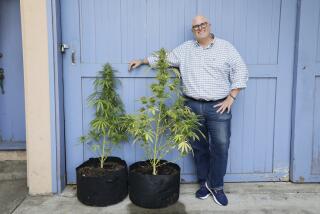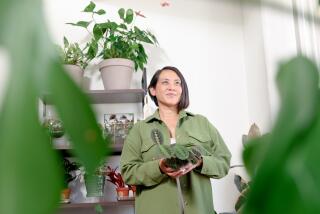Gardening : A Plant You Know May Be Calling for Help
- Share via
One of the saddest chores for any indoor gardener is throwing away a plant. I know, it’s just a plant. But sometimes plants can become good friends, practically members of the family, and it’s always painful to send one to that “great greenhouse in the sky.”
The good news is that many of those plants you thought were beyond help actually only need some tender-loving care to be returned to their former states of thick, lush beauty. But as in anything else, a few ounces of prevention and a basic knowledge of the fundamentals of indoor plant care will greatly improve you plants’ chances of survival and spare you the travails of a revival. While pests and plant diseases do take their toll, the primary cause of plant death is human error--failure to cultivate the plant properly.
There are several basic ingredients in proper plant maintenance. They are, in no particular order, providing water, humidity, light, food, grooming, being aware of pests, playing music for your plants, and giving them love.
Although some plants need more or less of each of these elements than others (although all need lots of love), here are some general rules that will help you to maintain the lushest, greenest plantation on your block.
Water
All plants need water to live. Certain plants, like cactus and succulents which store water in their stems and leaves, need very little. Others, such as flowering plants and ferns, need to be watered frequently, before their soil dries out.
There is one general rule which you should keep in mind: With the above exceptions, never water your plants until the soil is dry to the touch about one inch down. More plants die from overwatering than any other cause. You will know your plant needs water if its leaves begin to droop. If brown or yellow spots begin to appear on the leaves of a plant, you’re overwatering. Stop watering until the soil dries out.
If necessary--if the plant has really been drowned--unpot it, remove most of the soil and transplant into fresh, dry commercial potting mix.
A few other watering tips:
Small plants in small pots need to be watered more frequently than larger ones; plants in plastic containers need less water than those in terra cotta because the plastic retains the water longer than clay; and plants in bright, sunny windows will dry out more quickly than those in darker spots.
Humidity
Humidity is critically important to every houseplant. Remember, most of the more common foliage houseplants grow wild in tropical climates, so the closer we can come to approximating their natural habitats, the better they will do.
Two major humidity-reducers are dry heat in winter and air conditioning in summer, but you can fight these potential plant killers in various ways. Place your plants on “dry wells”--saucers or trays filled with pebbles and water. The water will evaporate upward and raise the humidity around the plant.
Mist your plants at least once a day, and, if they look good together, arrange them in groups. Plants transpire--give off their own humidity--so grouping can be very helpful.
During the summer, take your more temperamental plants outside and put them in a shady spot. They may have a little trouble readjusting when you bring them in at the beginning of fall, but they’ll manage, and, just like humans, they’ll benefit greatly from the vacation--and the comparatively high humidity outdoors.
Food
Since houseplants will eventually consume the nutrients in their soil, new nutrients must be added from time to time.
Here’s a rule of (green) thumb about feeding your plants: Use a good, commercial liquid houseplant food--a formulation of 8-7-6 is recommended. (These numbers stand for the percentage of nitrogen, phosphoric acid, and potash in the food. Nitrogen stimulates leaf growth, phosphates are the root makers, and potash helps the plant to bloom.)
Feed your plants once a week during their peak growing seasons, spring and summer, and cut back to once a month during the fall and winter. Flowering plants, especially African violets, should be fed every week all year around with the exception of a month off in December. Plants that are underfed will grow slowly, if at all, and new growth will be pale and very small.
Light
All houseplants need light, but very few, with the exception of cactus and succulents, need direct sunlight.
As a rule, most plants will do just fine with average light, either natural or artificial. Some plants need less light than others--among them aspidistra, Chinese evergreen, neanthe bella palm, philodendron, sanseveiria, and spathyphyllum. A northern or eastern exposure is fine for these plants.
Others, particularly flowering plants and plants with brightly colored leaves, need more light--filtered western or southern sunlight is best for these.
If your plant is not getting enough light, it will droop, some of the leaves will turn yellow, it will fail to grow, and if it’s a flowering plant it won’t produce its expected blooms. If it’s getting too much light, it will fade, lose its luster, and eventually sear.
Plants should be rotated so that each side gets equal exposure to the light source and will thus grow evenly. If you haven’t got enough natural light to grow houseplants, don’t despair. Florescent lights are just fine for most foliage plants, and even your flowering plants will do well under special plant-growing light bulbs.
Grooming
Keep the foliage of your leafy plants dust-free with regular spraying and an occasional bath with a mild dishwashing soap and water (one part soap to 10 parts water). This helps keep dust out of the stomata, or breathing cells of the plant.
Pruning, or cutting back your plants, is vital to keep them looking and growing their best. Although every plant benefits from an occasional pruning--the process encourages new and bushier growth--some plants need haircuts more frequently than others.
Because they’re hung where the humidity is at its lowest and the heat is at its highest, hanging or vining varieties, such as ferns, Swedish ivy, wandering Jew, etc., will frequently dry up. These plants should be cut back as soon as they begin to turn brown and straggly.
Beware of Pests
Although, as I’ve said, human error kills more plants than anything else, pests do take their toll. Mealybugs, scale, aphids, whiteflies, thrips and red spider mites are among the most common critters that attack houseplants.
An ounce of prevention--keeping your plants clean, using sterilized potting mix and checking plants carefully for pests before you buy them--is usually worth a pound of cure.
But sometimes, despite our precautions, pests attack. The first thing to do when you notice pests is to separate the affected plant from other plants. Then spray the plant thoroughly with any commercially available insecticidal soap or indoor plant spray. A few applications should rid of the plant of its problem.
Music and Love
It has been written that music soothes the savage breast. It also helps the plants to grow, and that’s been proven scientifically.
I know it sounds weird, but plants are living things, after all, and your attention, the sounds of music, and your gentle voice will stimulate their breathing cells and generally keep them happier and healthier.
There’s a raft of sophisticated scientific evidence to support this, but the best experiment was one I observed myself: Several years ago, a botanist friend of mine at Occidental College took three sets of identical plants and put them into three separate rooms with identical growing conditions. In the first room, he played only rock music to the plants and they thrived. In the second room he played only classical music and they thrived. In the third room, he played only the news and those plants all died.
I believe!
Although very often the same symptom may be caused by different cultivation problems, be alert for the symptoms and try to figure out the cause. Yellowing leaves, dry leaves, spots or patches on the leaves, leaf drop, brown tips, no growth, no flowering, rotting leaves, and stems: these are the ways your plants talk to you. Be sure to listen. The life you save might be a plant’s!






